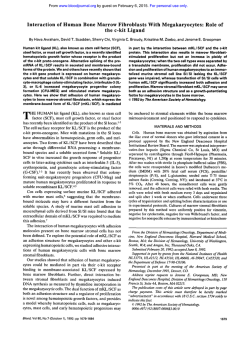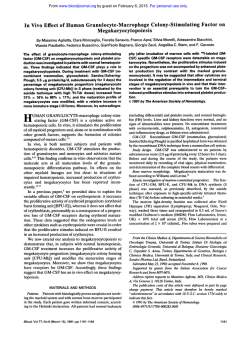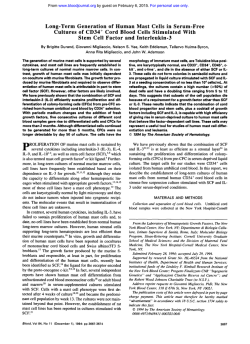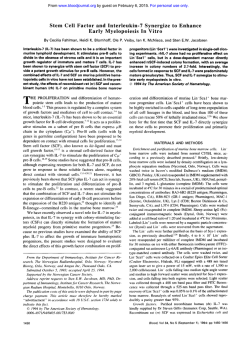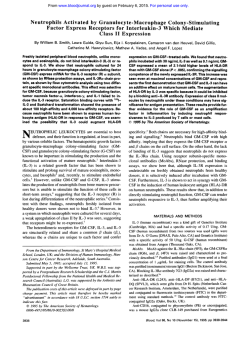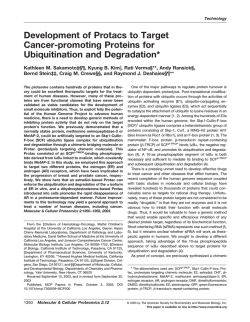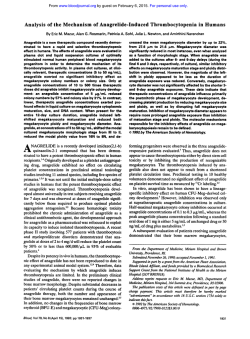
Effects of the Stem Cell Factor, c-kit Ligand, on Human
From www.bloodjournal.org by guest on February 6, 2015. For personal use only. Effects of the Stem Cell Factor, c-kit Ligand, on Human Megakaryocytic Cells By Hava Avraham, Edouard Vannier, Sally Cowley, Shuxian Jiang, Sheri Chi, Charles A. Dinarello, Krisztina M. Zsebo, and Jerome E. Groopman The kit ligand (KL), also termed stem cell factor (SCF), is a recently discovered hematopoietic growth factor that augments response of early progenitor cells t o other growth factors and supports proliferation of continuous mast cell lines. Histological studies suggest that the receptor for SCF/KL, the c-kit proto-oncogene product, is present in bone marrow megakaryocytes. We studied the effects of SCF/KL on immortalized human megakaryocytic cell lines (CMK, CMK6, and CMK11-5) and on isolated human marrow megakaryocytes. Human SCF/KL alone or in combination with the hematopoietic growth factors, interleukin-3 (IL-3). granulocyte-macrophage colony-stimulating factor (GM-CSF), and IL-6, stimulated proliferation of these megakaryocytic cell lines. SCF/KL treatment did not alter expression of gplb, gpllb/llla, LFA-1, ICAM-1, or GMP-140 in CMKcells. No effect on ploidy was observed. Furthermore, human SCF/KL induced expression of IL-la, IL-lp, IL-2, and IL-6 in CMK cells. In a fibrin clot system, SCF/KL modestly potentiated megakaryocyte colony formation when added alone t o cultures containing CD34’, DR’ bone marrow cells. Addition of SCF/KL with IL-3 or GM-CSF t o these cultures resulted in a more marked increase in colony number. Modest stimulatory effects were observed when SCFfKL was added t o more mature marrow megakaryocytic cells. SCF/KL may directly affect megakaryocytopoiesis, as well as secondarily modulate hematopoiesis through induction of cytokines in target cells. o 1992b y The American Society of Hematology. A vided by Amgen (Thousand Oaks, CA). IL-1p was provided by Dr C. Dinarello (Tufts University, Boston, MA). Plateau doses of each factor were determined from dose-response curves and used for culture at the following concentrations: SCFKL, 100 ng/mL; IL-6, 10 ngimL; IL-lp, 10 ngimL; IL-3, 10 ngimL; GM-CSF, 200 ng/mL; and G-CSF, 500 ng/mL. Monoclonal antibodies. Monoclonal antibodies for gpIb and gpIIbiIIIa, as well as other monoclonal antibodies for glycophorin A, CDla, CD3, CD4, CD8, CD9, CD1.5, CD16, CD33, CD34, and HLA Class I, were supplied by Becton Dickinson (Mountain View, CA). Monoclonal antibodies TS1122 and TSlIl8 recognize the LFA-la subunit and LFA-1f3subunit, respectively, and were kindly provided by Dr T.A. Springer (Center for Blood Research, Harvard Medical School, Boston, MA).’ Monoclonal antibody RR1/1, which recognizes ICAM-1 (CD54):was also provided by Dr T.A. Springer. Polyclonal antibodies against GMP-140 were kindly provided by Dr Bruce Furie (Tufts University Medical School). Cell culture. Three different clones of the immortalized parent megakaryocytic cell line CMK (termed CMK6, CMK11-5, and CMK cells) were grown in RPMI 1640 medium with 10% fetal calf serum (FCS) or with 7.5% platelet-poor plasma supplemented with 2 mmoliL L-glutamine, and 50 kg/mL penicillin and streptomycin (GIBCO Laboratories, Grand Island, NY), as described.“’.” The immortalized Dami megakaryocytic cell line’’ and the immortalized CHRF megakaryocytic cell line’3 were kindly provided by Dr S.M. Greenberg (Brigham and Women’s Hospital, Boston, MA) and Dr L. Zon (Children’s Hospital, Boston, MA), HEMATOPOIETIC growth factor derived from mesenchymal cells that supports the proliferation of early hematopoietic progenitors and of permanent mast cell lines was recently identified.’” The cell surface receptor for this hematopoietic growth factor has been identified as the product of the c-kit proto-oncogene. The growth factor has been termed kit ligand (KL), stem cell factor (SCF), and mast cell growth factor (MGF), based on its in vitro effects with respect to growth stimulation and receptor binding. Recent studies in non-human primates demonstrate that recombinant human SCF/KL is biologically active and augments production of cells of myeloid and erythroid lineages: The absolute number of megakaryocytes in the bone marrow also increased after SCF/KL administration. A modest increase in circulating platelet number was observed in these initial studies. Histologic studies of normal human bone marrow using specific antibodies to the c-kit protein have suggested expression of this surface structure on immature blast-like cells and on megakaryocytes.* We have studied the effects of human SCFIKL. on several permanent human megakaryocytic cell lines to provide a model of its modulation of growth and function in cells of this lineage.5 SCF/KL significantly increased the proliferation of immortalized human megakaryocytic cell lines in vitro. SCF/KL also induced gene expression for cytokines. These studies using the CMK cell lines as a model prompted us to investigate the effects of SCF/KL alone and in combination with other hematopoietic growth factors on human megakaryocytopoiesis. Using a serum-depleted fibrin clot assay system, we observed proliferative effects of SCF/KL on the CD34+DR’ human bone marrow subpopulation, which is enriched for the colony-forming unit megakaryocyte (CFU-MK)6 and on megakaryocytes isolated by immunomagnetic beads’ using anti-human glycoprotein gpIIb/IIIa monoclonal antibody. MATERIALS AND METHODS Growth factors. Human SCFiKL was cloned and expressed in Escherichia coli and purified as previously described.” Human SCF/KL, human interleukin-3 (IL-3), human granulocyte-macrophage colony-stimulating factor (GM-CSF), human IL-6, and human granulocyte colony-stimulating factor (G-CSF) were proBlood, Vol79, No 2 (January 151,1992:pp 365-371 From the Division of HematologyiOncology, New England Deaconess Hospital, Harvard Medical School, Boston, MA; the Division of GeographicMedicine and Infectious Diseases, Tufts University School of Medicine, Boston, MA; and Amgen, lnc, Thousand Oaks, CA. Submitted March 15, 1991; accepted September 19, 1991. Supported in part by Grants No. HL33774, HL42112, HL46668, A129847, and AI-15614from the National Institutes of Health, and by the Department of Defense Grant No. DAMD 17-90-C-0106. Address reprint requests to Jerome E. Groopman, MD, Division of HematologyiOncology, New England Deaconess Hospital, 110 Francis St, 4A, Boston, M A 02215. The publication costs of this article were defrayed in part by page charge payment. This article must therefore be hereby marked “advertisement” in accordance with I 8 U.S.C. section 1734 solely to indicate this fact. 0 1992 by The American Society of Hematology. 0006-49711921 7902-0025$3.00/0 365 From www.bloodjournal.org by guest on February 6, 2015. For personal use only. 366 respectively. The Dami cell line was grown in Iscove's modified Dulbecco's medium (IMDM) containing 10% horse serum. The CHRF cell line was grown in Fisher's medium containing 25% horse serum. Bone marrow preparation and fractionation of marrow cells. Ten milliliters of bone marrow aspirate was collected from one site of the sternal bone or posterior iliac crest of normal volunteers who had given informed consent. Cells were collected into 20-mL plastic syringes containing 1/10 vol of acid-citrate-dextrose (ACDIA) and EDTA to a final concentration of 2.5 mmoliL. One volume of marrow aspirate was mixed with 1 vol of MK medium, which consisted of Ca2'-MgZ' free phosphate-buffered saline (PBS) containing 13.6 mmoliL sodium citrate, 1mmoliL theophylline, 1% bovine serum albumin (BSA, fraction V; Sigma Chemical, St Louis, MO, and 11 mmoliL glucose, adjusted to pH 7.3 and an osmolarity of 290 mOsmiL. The cell suspension was layered over two different kinds of Percoll(5 mL; Pharmacia, Uppsala, Sweden) at densities of 1.020 g/mL and 1.050 g/mL containing 13.6 mmoliL sodium citrate. The 1.020 Percoll density cut was helpful in preventing aggregate formation, and most morphologically identifiable megakaryocytes were contained in the fraction heavier than 1.020 g/mL and lighter than 1.050 g/mL. After centrifugation at 400 x g for 20 minutes, the upper medium layer was removed, and the cells were collected from the interface ( < 1.050 g/mL). These cells were washed twice with MK medium and adjusted to a concentration of 1 to 5 x 106/mLwith MK medium. Isolation of megakaiyocytes. The light-density ( < 1.050 gimL) cells were mixed with 10 ILLof monoclonal antibody directed to the human platelet glycoprotein (gp)IIb/IIIa complex and incubated for 1 hour at 4°C. After washing completely with MK medium, 20 KLof 10 times diluted immunomagnetic beads (4 x lo7beadsiml) coated with anti-mouse IgG antibody (Dynabeads M-450, Dynal, Oslo, Norway) were added to the cell suspension in 1mL. The cells rosetted with immunomagnetic beads were collected with a Dynal magnetic particle concentrator (Dynal MPC l),washed three times with MK medium, and resuspended with 10% FCS in RPMI 1640 medium. Serum-depleted assay system. Megakaryocyte progenitor cells were isolated and separated into a nonadherent, low-density, T-cell-depleted (NALDT), marrow subpopulation.6 The NALDT were further enriched for megakaryocyte progenitors (CFU-MK) by using monoclonal antibodies for anti-CD34 and anti-HLA-DR. The NALDT- marrow cells consistently contained greater than 94% CD34 and HLA-DR-positive cells. Approximately, 5 X lo3 CD34+, DR+ were assayed for their ability to produce CFU-MK derived colonies in a serum-depleted fibrin clot culture system as described.I4Various concentrations of SCF/KL, alone or in combination with other hematopoietic growth factors, were added and the cultures were incubated for 12 to 14 days at 37°C in a 100% humidified atmosphere of 5% CO, in air. Viability and identification of megakaryocytes. Viability of separated cells was assessed by trypan blue exclusion. Megakaryocytes were identified by Wright's staining and flow cytometric expression of gpIIbiIIIa and gpIb. The maturation stages of the megakaryocytes were classified by cell size, nuclear morphology, and cytoplasmic staining.' Flow cytometiy. For flow cytometry, 5 x lo5cells were exposed to monoclonal antibodies (4"C, 30 minutes), washed three times, and followed by fluorescein-conjugated goat anti-mouse IgG (Boehringer Mannheim Biochemicals, Indianapolis, IN) (150 dilution in Hanks balanced salt solution [HBSS] with 0.1% BSA, at 4°C for 20 minutes) and fixed in 1% paraformaldehyde in PBS. Immunojuorescentstainingfor GMP-140. The CMK cells grown on glass coverslips were fixed in PBS containing 3.7% formaldehyde for 20 minutes and permeabilized for 15 minutes with 0.5% AVRAHAM ET AL Triton X-100 in the same buffer. Antibodies to GMP-140 (50 KgimL) were added for 30 minutes at 4"C, washed three times, and followed by fluorescein-conjugated goat anti-rabbit IgG (Boehringer-Mannheim) (1:50 dilution in HBSS with 0.1% BSA, at 4°C for 20 minutes). The coverslips were mounted in Geevatol and photographed through a Zeiss Axioscope microscope (Carl Zeiss, Germany) equipped with a fluorescein filter set. Preparation ofphorbol-l2-myristaie-I 3-acetate (PU4)-treated CMK cells. PMA (Sigma) was dissolved in dimethylsulfoxide (DMSO) and stored at 80°C.Just before use, PMA was diluted in the RPMI culture medium. Cells were incubated with PMA at a concentration of 50 ngimL or 100 ng/mL at 37°C in a 5% CO, humidified atmosphere for 3,6,24, or 48 hours as indicated. Flow cytometric measurement of DNA content of CMK cells. CMK cells were seeded at 2 x lo5 cells and fed again after 2 days. Cells were harvested after 5 days and the nuclei were isolated, stained with propidium iodide, and analyzed on a Becton Dickinson FACS Analyzer as previously described.I2 Freshly prepared lymphocytes were used to mark the position of the 2N cells. Proliferation assays. Cell proliferation and viability was assessed by ['Hlthymidine incorporation and by trypan blue exclusion (0.4% trypan blue stain in 0.85% saline; GlBCO Laboratories). Dilutions of growth factors were made in 96-well flat-bottom tissue culture plates (Costar, Cambridge, MA) in the appropriate growth medium containing either 1% platelet-poor plasma or 1% FCS in a final volume of 50 pL. For [3H]thymidine incorporation assays, cells were seeded at time zero (50 KL vol) and the plates were incubated at 37°C in a humidified atmosphere of 5.5% CO, for 48 hours. Cells were pulsed with 0.5 Ci per well of [-'H]thymidine (25 Aimmol; DuPont-New England Nuclear, Boston, MA) and incubated for an additional 5 hours. Samples were harvested onto glass fiber filters and counted by liquid scintillation spectrometry. The concentrations of cytokines added at the initiation of the cultures were SCFIKL, 100 ng/mL; IL-3,10 ng/mL; GM-CSF, 200 ng/mL; IL-6,10 ng/mL; IL-lp, 0.5 ng/mL; and G-CSF, 500 ng/mL. RNA isolation and Northern blot analysis. Total RNA from CMK cells was extracted by the guanidine isothiocyanate procedure, followed by ultracentrifugation through a CsCl cushion.15For each sample, 20 pg of total RNA was electrophoresed in a 1% agarose, 6% formaldehyde gel, and blotted to an S & S Nytran membrane (Schleicher & Schuell, Keene, NH). The blot was prehybridized as described' for 6 hours and then hybridized overnight at 42°C with radiolabeled probe (1 to 3 x lo6cpm/mL). The blot was washed as described' and exposed to Kodak XAR-5 film (Eastman Kodak, Rochester, NY) with intensifying screens at -70°C. DNA probes. Expression of the c-kit gene was assessed by Northern blot analysis using a 1,250-bp fragment of human c-kit gene subcloned in phc-kit 171 (ATCC 59492). Cytokine analysis. Total cellular RNA was extracted from the CMK cell lines, as indicated above, with or without SCFiKL treatment (100 ng/mL). Total RNA was run on a 1.2% formaldehyde agarose gel and the intact RNA was visualized by ethidium bromide staining. Reverse transcription (RT) of RNA was performed using 2 pg of total RNA from each sample and polymerase chain reaction (PCR) assays for each primer set was set up according to Clontech's Cytokine Mapping PRI-MATE methods (Clontech Laboratories, Palo Alto, CA). The following human primer sets were used: IL-la (816 bp); IL-1p (811 bp); IL-2 (453 bp); GM-CSF (420 bp); tumor necrosis factor-a (TNF-a) (691 bp); p-actin primer set (584 bp, or 300 bp, or 100 bp). The products for each set were analyzed on a 2% agarose gel (BRL, Bethesda, MD). The amplified DNA bands were visualized with a UV transilluminator. Internal reaction standards for PCR controls were performed for each set of primers, which included From www.bloodjournal.org by guest on February 6, 2015. For personal use only. 367 SCF/KL, EFFECTS ON MEGAKARYOCYTIC CELLS RNA with or without primers: primers without RNA: primers with target DNA provided by the PCR kit (Cetus-Perkin Elmer, Emeryville, CA) as positive control; and mRNAwith actin primers. All the primer stocks and total mRNA preparations were analyzed to exclude contamination by cellular DNA. These studies for cytokine expression provide qualitative information about the presence or absence of mRNA for cytokines. First-strand cDNA synthesis. First-strand DNA was synthesized at 37°C for 1 hour in a final volume of 10 p L with oligo-dT as primer: 4.5 p L RNA in DEPC-dH,O. 2.0 pL 5 x buffer (250 mmol/LTris-HCI, pH 83,375 mmol/L KCI, 50 mmol/L dithiothreitol, 15 mmol/L MgCI,, and 250 pglmL actinomycin D), 0.5 p L RNAsin (40 UlpL, Promega, Madison, WI), 1.0 p L dNTP (dATP, dCTP, dGTP, dTTP mix, 10 mmol/L each: Pharmacia, Piscataway, NJ), 1.0 FL oligo-dT, 1.0 p L Moloney murine leukemia virus (MMLV) RT (200 UlmL, Boehringer-Mannheim. Chicago, IL). PCR. Eighty microliters of PCR mix was added to 10 pL of first-strand cDNA. PCR mix contains 53.5 p L sterile water, 10 p L I0x reaction buffer, 16 p L dNTP mix (each at 1.25 mmol/L), and 0.5 p L (2.5 U) of the Thennus aquaticits thermostable DNA polymerase (Cetus-Perkin Elmer). PCR reaction buffer ( 1 0 ~ ) contains 500 mmollL KCI, 100 mmol/L 0.1% gelatin. Five microliters of each primer (final primer concentration, 1 FmollL) was added and the mixture was then subjected to PCR amplification using the Perkin-Elmer thermal cycler set for 40 cycles. The temperatures used for PCR were denature 94°C. 1 minute: primer anneal 5ST, 2 minutes: primer extension 72"C, 3 minutes. Normally. I-minute ramp times were used between these temperatures. Ethidium bromide-stained 2% agarose gels were used to separate PCR fragments. c-kit analysis hv PCR. Total RNA from CMK cells was used as a template for reverse transcription and PCR assays for c-kit primer set was set up as described above. The primers were provided by Amgen.' The expected size of the c-kit cDNA synthesized, using the c-kit primers, was 143 bp, and was verified by hybridization using the c-kit probe. Cytokine assays. For cytokine assays, CMK cells were grown in RPMI 1640containing 1% platelet-poor plasma at a density of 5 x 10"lmL. Cell suspensions were centrifuged for 10 minutes at 1,200 rpm. Supernatants and cell pellets were assayed for cytokine production by specific radioimmunoassays (RIAs) as described for TNF-a,16IL-lp,'7IL-la," and GM-CSF."The sensitivities (defined as 95% binding) of RIAs for TNF-a, IL-Ip, IL-la. IL-6, and GM-CSF were 42 13,32 f 3,28 f 7.22 2 2, and 25 4 pg/mL, respectively.''' In addition, cytokine assays were performed on CMK cells stimulated with SCF/KL (100 ng/mL), GM-CSF (200 ng/mL), G-CSF (500 ng/mL), IL-6 (10 nglmL), IL-3 (10 ng/mL). IL-Ip (10 ng/mL), or combinations of these cytokines for 48 hours. Supernatants and cell pellets were assayed for cytokine production. Statistical ana!vsis. The results were expressed as the mean 2 SEM of data obtained from two or more experiments performed in duplicate or triplicate. Statistical significance was determined using the Student's t-test. * IIIa, which is a structure specifically expressed on megakaryocytcs and platelets, was expressed in 71% of the less mature CMK6 cells, approximately 86% of CMK cells, and 94% of more mature CMKll-5 cells. Effect of SCFIKL on proliferation of immortalized CMK cells. The CMK megakaryocytic cell lines were analyzed for their proliferative response to various concentrations of exogenous SCF/KL. As shown in Fig 1, all the megakaryocytic ccll lines exhibitcd a proliferative response to SCF/KL in a dose-dependent fashion as asscssed by counting the number of viable cells. The CMK cell lines showed higher proliferation rates in rcsponsc to SCF/KL as comparcd with the Dami and CHRF cell lines. Maximum growth stimulation was seen at a SCF/KL concentration of 10 ng/mL in evcry ccll line tested. However, the maximum growth reached by CMK ccll lines after 48 hours was higher compared with the maximum growth reached by Dami or CHRF cclls. Prolifcration of CMK cclls was augmcntcd by combinations of human SCF/KL with the hematopoietic growth factors IL-3, GM-CSF, and IL-6 (Fig 2). These proliferation assays were initially performed at submaximal concentrations of each growth factor and then at optimal combinations of these growth factors as described in the Methods. We did not observe any pronounced enhancement when suboptimal concentrations of these cytokines were used. The combination of human SCF/KL with GM-CSF, IL-3, or IL-6 resulted in higher levels of stimulation of CMK cell growth, but the effects were not fully additive. Effects of human SCFIKL on CMK cellfrtnction. Human SCF/KL treatment over a range of concentrations (10 ng/mL, 50 ng/mL, or 100 ng/mL) did not alter CMK cell surface expression of gpIb, gpIIb/IIIa, LFA-1, or ICAM-1, and did not induce expression of GMP-140 (data not shown). No effect on CMK ploidy was observed (data not shown). Effects of human SCFIKL on cytokine expression in CMK cells. The effects of SCF/KL on the gene expression for cytokines in CMK cells were studied using PCR analysis. 0 CMK-6 0 CMK t Z 2 CMK11-5 .. IDAM1 ICHRF RESULTS Expression of surface antigens by CMK cell lines. To explore the effects of purified recombinant human SCF/KL on human megakaryocytes, experiments were performed using the three immortalized CMK clones (CMK6, CMK, and CMKll-5), as wcll as the Dami and CHRF human ccll lines. The characterization of Dami cells" and CHRF cells" has been previously reported. For the three CMK clones, lymphoid surface antigens wcrc uniformly absent, as were those of granulocytes, monocytcs, and macrophages. gpllb/ 0 1 5 fi.. [ 100 SCF/KL ( n g / m l ) Fig 1. Effect of SCF/KL on the prolieration of human megakaryocytic cell lines. Cells (2 x lo5cells/mL) were cultured for 48 hours in the presence of SCF/KL (1 to 100 ng/mL). Cell numbers were determinedby counting viable cells by trypan blue exclusion. Data are mean SEM of pooled data from three separate experiments performed in duplicate. (0)Statisticallysignificant as compared with the control culture (P < .OS) From www.bloodjournal.org by guest on February 6, 2015. For personal use only. AVRAHAM ET AL 368 11-6 GMCSF Cylokines Fig 2. Effect of SCF/KL on proliferation of CMK cells in the presence of IL-3 or GM-CSF. CMK cells (6 x 10'/mL) were cultured with SCF/KL (100 ng/mL), IL-3 (10 ng/mL). GM-CSF (200 ng/mL), or combinations of these factors as indicated in Materials and Methods. Cell numbers were determined by trypan blue exclusion. Data are reported as mean -t SEM of triplicate cultures. ( 0 )Statistically significant as compared with the control culture (P < .05). Total RNA from CMK cells was used as a template for RT reactions. PCR mapping was performed using specific primers for each cytokine or cytokine receptor. These studies provided a readout of mRNAs being produced by CMK cells at a given point in time for the presence or absence of the examined cytokines. A number of cytokine genes were induced by treatment of CMK cells with human SCF/KL (Fig 3). There appeared to be differences in the IL1-p IL1-a 'A B C ' A B C DI I L-6 'A B C kinetics of expression of different genes with SCF/KL treatment. CMK cells were found to constitutively express moderate levels of mRNA for TNF-a and IL-1p (Fig 3). No induction of GM-CSF expression was observed after stimulation. Cytokine expression was detected after 6 hours of SCF/KL stimulation, which included IL-la, IL-2, and IL-6. This repertoire of cytokine mRNA expression was also present after 24 hours of SCF/KL treatment (Fig 3). All PCR standard controls were negative. DNA-positive controls with each primer set were positive, as well as the p-actin primers. Effect of human SCFIIU on cytokine production in CMK cells. Studies for cell-associated or secreted GM-CSF, TNF-a, IL-2, or IL-la by RIA showed that none of these cytokines was readily detectable in cultures of the unstimulatcd CMK cells (data not shown). Cell-associated IL-1p protein was detected (Fig 4) in unstimulated CMK cells, as well as after 3 hours and 24 hours of SCF/KL treatment. By 48 hours of SCF/KL treatment, the level of IL-lp was decreased. Low levels of TNF-a and IL-la were detected as secreted and cell-associated forms. RIA for IL-2 showed very low levels of secreted and cell-associated protein after SCF/KL treatment (data not shown). Although SCF/KL had a modest effect on IL-2 production by CMK cells, combinations of SCF/KL with GM-CSF or IL-3 markedly increased the level of secreted and cell-associated IL-2 protein (data not shown). D' ._' A 9 2322 D GM-CSF B C D' I L-2 E F ' ' A B C TNF-a A B C D' Actin D IG H I J' - - 564 4204 -- 500 300 +loo Fig 3. Mapping of CMK cells using amplimer sets for cytokines at 6 and 24 hours poststimulation with SCF/KL. Total RNA from CMK cells (10 x 10') or bone marrow megakaryocytes (10' cells) was prepared and mapped as described in Materials and Methods for the following cytokines: IL-la, IL-1s. IL-2, IL-6, GM-CSF, TNF-a, and pactin. Lanes: A, RNAfrom untreated CMK cells; B, 6 hours poststimulation with SCF/KL; C, 24 hours poststimulation with SCF/KL; D, DNA-positive control with each specific set primers; E, 6 hours poststimulation of isolated megakaryocytes by immunomagnetic beads; F, 24 hours poststimulation of isolated megakaryocytes by immunomagnetic beads; G. pactin primers with RNA from untreated CMK cells; H, pactin primers with RNA from SCF/KL stimulated CMK cells for 6 hours; I, pactin primers with RNA from SCF/ KL stimulated CMK cells for 24 hours; J, p-actin primers with RNA for SCF/KL stimulated megakaryocytes for 6 hours. From www.bloodjournal.org by guest on February 6, 2015. For personal use only. SCF/KL, EFFECTS ON MEGAKARYOCYTIC CELLS IL-10 TNF-a IL-6 IL-la 369 GM-CSF 5.L 0' 2 CELL-ASSOCIATED 9 1 -SECRETED r r - - - - r r 1 24 h I1 0.5 Fig 4. Production of TNF-re, IL-1s. IL-lu, IL-6, and GM-CSF by CMK cells for 3, 24, and 48 hours. CMK cells were stimulated by SCF/KL (100ngImL) or bySCF/KL(lOOng/mL) and PMA(lOng/mL)for3,24, or 48 hours and assayed for cytokine production in supernatants and cell pellets. ( 3 ) SCF; (C) PMA; (B) SCF PMA. + Effect of SCFIKL. on proliferation of primary human megakaryocytes. The direct effect of human SCF/KL on CMK cell proliferation suggested that the SCF/KL receptor would be present on the surface of primary human megakaryocytes. Constitutive expression of the 5.5-kb specific transcript of the c-kit gene was observed on isolated human megakaryocytes either by Northern blot analysis or by PCR analysis (Fig 5). We thus investigated the effects of this growth factor on megakaryocyte progenitors and mature megakaryocytes. The effects of addition(s) of SCF/KL, IL-3, GM-CSF, and IL-6, either alone or in combination, on CFU-MKderived colony formation are shown in Table 1. CFU-MKderived colonies appeared in the presence of SCF/KL, IL-3, and GM-CSF, but not IL-6 or G-CSF (P < .05). IL-3 significantly promoted megakaryocyte colony formation compared with either GM-CSF or SCF/KL. The addition of IL-3 plus SCF/KL or GM-CSF plus SCF/KL to cultures containing CD34+, DR' cells resulted in an increase in CFU-MK-derived colony formation over that stimulated by IL-3, GM-CSF, or SCF/KL alone (Table 1). This increase was additive, because the combination of the two cytokines approximated the sum of effects of the addition of each cytokine alone. IL-6 in combination with SCF/KL resulted in an increased number of CFU-MK colonies. The effects of SCF/KL alone or in combination with IL-3, GM-CSF, and IL-6 on the proliferation of marrow megakaryocytes isolated by immunomagnetic beads are summarized in Table 2, using the ['Hlthymidine uptake method. Both IL-3 and GM-CSF stimulated ['Hlthymidine incorporation of these isolated megakaryocytes. A modest but not statistically significant increase in ['Hlthymidine incorporation was observed after treatment with SCF/KL. The addition of IL-3, GM-CSF, or IL-6 to SCF/KL resulted in an increasc in ['Hlthymidine incorporation, although the increase was not fully additive compared with the sum of the effects of each cytokine. DISCUSSION Human SCF/KL has a broad range of activities in vitro. 1.3.: I Alone, the growth factor has modest effects on primitive progenitor cells,-'' but in combination with lateracting hematopoietic growth factors, such as GM-CSF, it acts to markedly increase the number and size of myeloid colonies in vitro. In combination with erythropoietin, human SCF/KL significantly stimulates erythropoiesis. Our studies demonstrate that immortalized cell lines with megakaryocytic properties, as well as human megakaryo- A +& ' G 5.5 kb Fig 5. Northern blot analysis of c-kif transcript. Total mRNA was prepared and analyzed as described in the Methods. Twenty micrograms of total RNA was analyzed. Cells used were CMK-6 (lane l), CMK (lane 2). CMK11-5 (lane 3) and PMA (10 ng/mL)stimulated CMK for 24 hours (lane 4). Arrows indicate the positions of 18s and 28s ribosomal RNAs. (A) Hybridization with c-kit probe (after 5 days of exposure). (6)Ethidium bromide staining of the Northern blot. (C) Mapping of CMK cells and isolated megakaryocytes by PCR using primer pair and detector probe for e-kit as described in Materials and Methods. ma B 28S- PCR Analysis Southern Blot From www.bloodjournal.org by guest on February 6, 2015. For personal use only. 370 AVRAHAM ET AL Table 1. Effects of the Addition of Recombinant Cytokines on Megakaryocyte Colony Formation Addition io Culture None SCF/KL (10 ng/mL) SCF/KL (25 ng/mL) SCF/KL (50 ng/mL) SCF/KL (100 ng/mL) IL-3 (10 ng/mL) GM-CSF (200 ng/mL) IL-6 (10 ng/mL) G-CSF (500 ng/mL) IL-3 (10 ng/mL) + SCF/KL (100 ng/mL) GM-CSF (200 ng/mL) SCF/KL (100 ng/mL) IL-6 (10 ng/mL) SCF/KL (100 ng/mL) G-CSF (500 ng/mL) SCF/KL (100 ng/mL) + + + Table 2. Effects of SCF/KL on the Proliferationof Megakaryocytes Factor L3H]Thymidine Incorporation IcDm 2 SEM) Medium SCF/KL (10 ng/mL) SCF/KL (50 ng/mL) SCF/KL (100 ng/mL) IL-3 (10 ng/mL) GM-CSF (200 ng/mL) IL-6 (10 ng/mL) IL-3 (10 ng/mL) SCF/KL (100 ng/mL) GM-CSF (200 ng/mL) + SCF/KL (100 ng/mL) IL-6 (10 ng/mL) SCF/KL (100 ng/mL) 5,630 ? 258 5,810 f 45 7,231 2 120 8,761 f 225 14,687 2 236 14,053 f 631 7,220 f 189 19,103 2 250*t 18,992 f 389*t 10,775 ? 225 Mean Colonies z S E M 0.0 f 0.0 0.0 ? 0.0 2.0 f 0.1 3.6 ? 0.2 4.5 f 0.5 10.9 ? 0.8 5.6 f 0.6 0.3 ? 0.1 0.5 ? 0.1 16.3 ? 2.0*t§ 10.5 2 1.3**§ 6.3 f 0.6*T 4.2 f 0.3*1I + + CD34'. DR' cells were plated at 5 x 103/mL.Results are expressed as mean number of megakaryocyte colonies 2 1 SEM taken from three separate studies performed in duplicate. *Statistically significant as compared with the control culture (P < .05). tStatistically greater than IL-3 alone (P < .05). *Statistically greater than GM-CSF alone (P < .05). §Statistically greater than SCF/KL alone (P < .05). TStatistically greater than IL-6 alone (P < .05). llStatistically greater than G-CSF alone (P < .05). cytes, express the c-kit gene product and directly respond to human SCFIKL. The role of SCF/KL in promoting human megakaryocyte colony formation was studied, using a serumdepleted fibrin clot assay system. SCF/KL showed modest stimulatory effects on megakaryocyte colony formation when added alone to cultures containing CD34', DR' bone marrow cells. When SCF/KL was added to these cultures in combination with GM-CSF, IL-3, or IL-6, a greater increase in CFU-MK-derived colony formation was observed. However, when SCF/KL was added to megakaryocytes isolated by immunobeads using anti-gpIIb/IIIa monoclonal antibodies, its effect on proliferation was modest. When SCF/KL was added to megakaryocyte cultures in combination with IL-3 or GM-CSF, a nearly additive proliferative effect was observed. The augmented increase in CFU-MK-derived colony formation associated with the addition of SCFIKL and IL-3 or SCF/KL and GM-CSF was paralleled by the effects seen on permanent cell lines with megakaryocytic properties. CMK cells have previously been reported to produce a variety of cytokines whose genes can be induced by agents such as PMA in vitro.6 Human SCFiKL treatment of CMK cells led to increased expression of the genes for several cytokines, including IL-1 species and IL-6. Human SCFIKL may thereby promote early hematopoiesis by increasing proliferation via activation of the c-kit receptor on progenitor cells, as well as by inducing production of certain cytokines by mature hematopoietic cells, such as megakaryocytes. We observed induction of IL-1p in marrow mega- SCF/KL at the indicated concentration was added to the cells (105/mL) for 48 hours in a final volume of 0.1 mL followed by 5-hour pulse with [3Hlthymidine. Megakaryocytes were isolated by immunomagnetic beads. Data are mean f SEM for triplicate cultures in each experiment after substraction of the medium (control). P < .05. These results are comparable with those seen in three other similar experiments. *Statistically significant as compared with the control culture (P < .05). tStatistically greater than SCF/KL alone (P < .05). karyocytes following SCFIKL treatment (Fig 3). Megakaryocyte-derived cytokines such as IL-1 could amplify the effects of SCFIKL on early progenitors. Further studies on human SCF/KL induction of cytokines in responsive cell types, such as mast cells and blasts, will be of interest in this regard. Several hematopoietic growth factors, including GMCSF, IL-3, and IL-6, have previously been reported to augment megakaryocyte proliferation and maturation in vitro.6,22-25Our study suggests that these growth factors may act in combination with SCF/KL to further augment human megakaryocyte progenitor cell growth. It will be particularly interesting to extend these in vitro observations to in vivo studies in non-human primates and, ultimately, in humans. Such trials should determine which combinations of growth factors result in stimulation of megakaryocytopoiesis under physiological conditions and after radiation therapy or chemotherapy, which suppress bone marrow activity. Human SCF/KL is a broadly acting hematopoietic growth factor that augments in vitro, and under certain in vivo conditions, myelopoiesis, erythropoiesis, and lymphopoiesis. Based on our in vitro observations of direct effects of SCF/KL on cell lines with megakaryocytic properties, megakaryocyte progenitors, and isolated primary marrow megakaryocytes, the augmentation of megakaryocyte number observed after invivo treatment of primates4may reflect direct proliferation of these cells in response to treatment with human SCFIKL. Such effects on megakaryocytopoiesis may ultimately be most evident when human SCF/KL is used in combination with other hematopoietic growth factors. REFERENCES 1. Zsebo KM, Williams DA, Geissler EN, Broudy VC, M a r t i n FH, Atkins HL, Hsu RY, Birket NC, O k i n o KH, M u r d o c k DC, Jacobsen FW,Langley KE, Smith KA, Takeishi T, Cattanach BM, G a l l i SJ, Suggs SV: Stem cell factor is encoded at the SI locus of the mouse and is the ligand f o r the c-kif tyrosine kinase receptor. Cell 63:213,1990 From www.bloodjournal.org by guest on February 6, 2015. For personal use only. SCF/KL, EFFECTS ON MEGAKARYOCYTIC CELLS 2. Huang E, Nocka K, Beier DR, Chu T-Y, Buck J, Lahm H-W, Wellner D, Leder P, Besmer P: The hematopoietic growth factor KL is encoded by the SI locus and is the ligand of the c-kit receptor, the gene product of the W locus. Cell 63:225,1990 3. Anderson DM, Lyman SD, Baird A, Wignall JM, Eisenman, Rauch C, March CJ,Boswell HS, Gimpel SP, Cosman D, Williams DE: Molecular cloning of mast cell growth factor, a hematopoietin that is active in both membrane bound and soluble forms. Cell 63:23, 1990 4. Andrews RG, Bartelmez SH, Egrie J, Bernstein ID, Zsebo K Recombinant human stem cell factor stimulates in vitro and in vivo hematopoiesis in baboons. Blood 76:10,1990 (abstr 509, suppl 1) 5. Avraham H, Vannier E, Chi SY, Dinarello CA, Groopman JE: Cytokine gene expression and synthesis by human megakaryocytic cells. Blood 76:446a, 1991 (abstr, suppl 1) 6. Briddell RA, Brandt JE, Straneva JE, Srour EF, Hoffman R: Characterization of the human burst-forming unit-megakaryocyte. Blood 74:145, 1989 7. Tanaka H, Ishida Y, Kaneko T, Matsumoto N: Isolation of human megakaryocytes by immunomagnetic beads. Br J Haematol 73:18, 1989 8. Martin FH, Suggs SV, Langley KE, Lu HS, Ting J, Okino KH, Morris CF, McNiece IK, Jacobsen FW, Mendiaz EA, Birkett NC, Smith KA, Johnson MJ, Parker VP, Flores JC, Patel AC, Fisher EF, Erjavec HO, Herrera CJ, Wypych J, Sachdev RK, Pope JA, Leslie I, Wen D, Lin CH, Cupples RL, Zsebo KM: Primary structure and functional expression of rat and human stem cell factor DNAs. Cell 63:203,1990 9. Larson RS, Corbi AL, Berman L, Springer TA: Primary structure of the LFA-1 alpha subunit. J Cell Biol108:703,1989 10. Sakaguchi M, Sat0 T, Groopman JE: HIV infection of megakaryocytic cells. Blood 77:481,1991 11. Komatsu N, Suda T, Moroi M, Tokuyama N, Sakato Y, Okada M, Nishida T, Hirai Y, Sat0 T, Fuse A, Miura Y: Growth and differentiation of a human megakaryoblastic cell line, CMK. Blood 74:42,1989 12. Greenberg SM, Rosenthal DS, Greenberg TA, Tantravahi R, Handin RI: Characterization of a new megakaryocytic cell line: The Dami cells. Blood 721968,1988 13. Witte DP, Harris RE, Jenski LJ,Lampkin BC: Megakaryoblastic leukemia in an infant: Establishment of a megakaryocytic tumor cell line in athymic nude mice. Cancer 58:238,1986 371 14. Bruno E, Briddell R, Hoffman R: Effect of recombinant and purified hematopoietic growth factors on human megakaryocyte colony formation. Exp Hematol 16:371, 1988 15. Maniatis T, Fritsch EF, Sambrook J: Molecular Cloning: A Laboratory Manual. Cold Spring Harbor, NY, Cold Spring Harbor Laboratory, 1982, p 185 16. Van der Meer JWM, Endres S, Lonneman G, Cannon JG, Ikejima T, Okusawa S, Gelfand JA, Dinarello C A Concentrations of immunoreactive human tumor necrosis factor alpha produced by human mononuclear cells in vitro. J Leukoc Biol43:216,1988 17. Lisi PJ, Chu CW, Koch GA, Endres S, Lonnemann G, Dinarello C A Development and use of a radioimmunoassay for human interleukin-1 beta. Lymphokine Res 6:229,1987 18. Katzen NA, Vannier E, Segal GM, Klempner MS, Dinarello CA: Granulocyte-macrophage colony stimulating factor and interleukin-1 production from human peripheral blood mononuclear cells as measured by specific radioimmuno-assays. (submitted) 19. Endres S, Ghorbani R, Lonnemann G , van der Meer JMW, Dinarello C A Measurement of immunoreactive interleukin-1 beta from mononuclear cells optimization of recovery, intrasubject consistency and comparison with interleukin-la and tumor necrosis factor. Clin Immunol Immunopathol49:424,1988 20. Schindler R, Mancilla J, Endres S, Ghorbani R, Clark SC, Dinarello CA: Production of IL-6, IL-1 and TNF in human blood mononuclear cells: IL-6 suppresses IL-1 and TNF. Blood 75:40, 1990 21. Zsebo KM, Wypych J, McNiece IK, Kent HS, Kent L, Smith A, Karkare SB, Sachdev RK, Yuschenkoff VN, Birkett NC, Williams LR, Satyagal VN, Tung W, Bosselman RA, Mendiaz EA, Langley KE: Identification, purification, and biological characterization of hematopoietic stem cell factor from Buffalo rat liverconditioned medium. Cell 63:195,1990 22. Debili N, Hegyi E, Navarro S, Katz A, Mauthon MA, Breton-Gorius J, Vainchenker W: In vitro effects of hematopoietic growth factors on the proliferation, endoreplication, and maturation of human megakaryocytes. Blood 77:2326,1991 23. Bruno E, Hoffman R: Effect of interleukin-6 on in vitro human megakaryocytopoiesis: Its interaction with other cytokines. Exp Hematol17:1038,1989 24. Briddell RA, Hoffman R: Cytokine regulation of the human burst-forming unit-megakaryocyte. Blood 76:516, 1990 25. Hoffman R: Regulation of megakaryocytopoiesis. Blood 74:1196,1989 From www.bloodjournal.org by guest on February 6, 2015. For personal use only. 1992 79: 365-371 Effects of the stem cell factor, c-kit ligand, on human megakaryocytic cells H Avraham, E Vannier, S Cowley, SX Jiang, S Chi, CA Dinarello, KM Zsebo and JE Groopman Updated information and services can be found at: http://www.bloodjournal.org/content/79/2/365.full.html Articles on similar topics can be found in the following Blood collections Information about reproducing this article in parts or in its entirety may be found online at: http://www.bloodjournal.org/site/misc/rights.xhtml#repub_requests Information about ordering reprints may be found online at: http://www.bloodjournal.org/site/misc/rights.xhtml#reprints Information about subscriptions and ASH membership may be found online at: http://www.bloodjournal.org/site/subscriptions/index.xhtml Blood (print ISSN 0006-4971, online ISSN 1528-0020), is published weekly by the American Society of Hematology, 2021 L St, NW, Suite 900, Washington DC 20036. Copyright 2011 by The American Society of Hematology; all rights reserved.
© Copyright 2025
